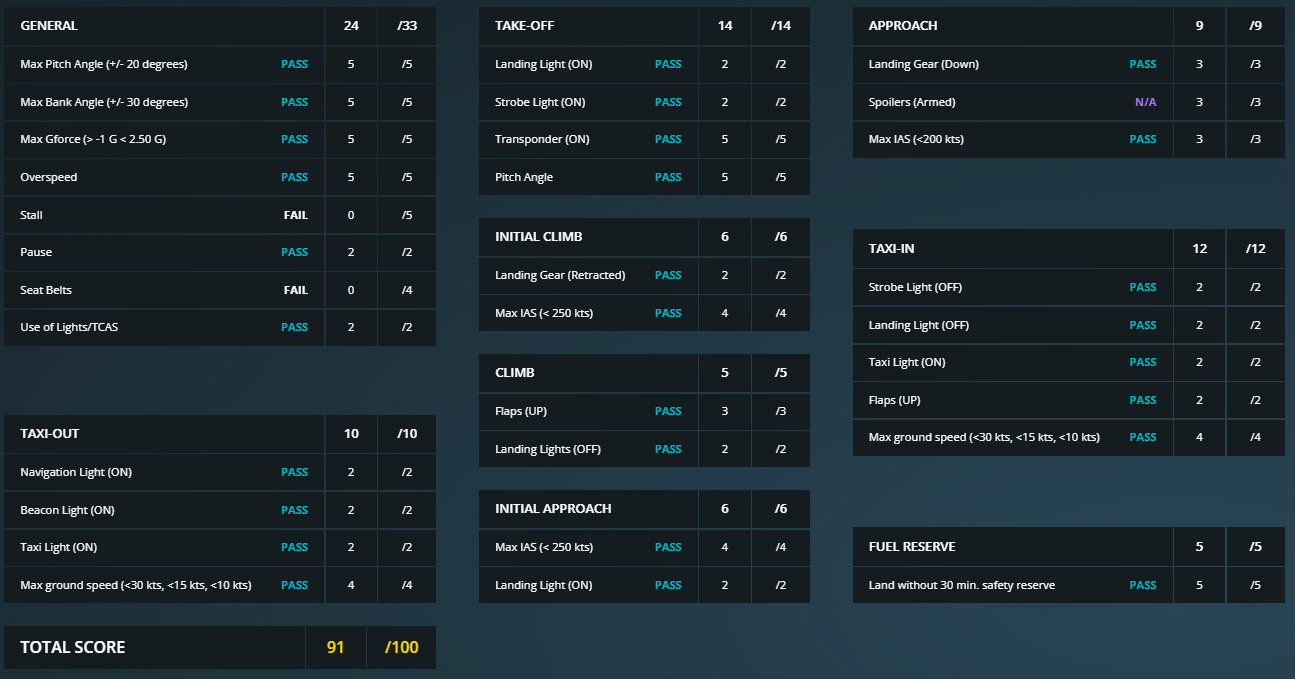Flight Data Analysis #
At the end of each flight, all data sent by the flight simulators are analyzed to assess the behavior of both the airplane and the pilot. At the start of the flight, the pilot begins with a score of 100 points. Any detected penalties deduct points based on the type, duration, or severity of the infraction. The more severe the infraction, the more points are deducted.
Report Generation and Scoring #
The flight is analyzed from the activation of the mission until its completion. The “Score” report is available immediately after the mission ends, but the data remains accessible for each flight in the “Flight Log” section. By pressing “View” next to the desired flight, you can review the entire previously completed flight.
The score achieved in the “Score” impacts the earning of P Sure, here’s the revised version with “airplane” replacing “aircraft”:
Report Generation and Scoring #
The flight is analyzed from the activation of the mission until its completion. The “Score” report is available immediately after the mission ends, but the data remains accessible for each flight in the “Flight Log” section. By pressing “View” next to the desired flight, you can review the entire previously completed flight.
The score achieved in the “Score” impacts the earning of PAX: the higher the score, the more PAX are earned. However, the “Score” does not influence the distribution of XP (experience points), which are determined solely by flight time (from takeoff to landing) based on the minutes available in the “XP-Eligible Flight Minutes” section.
Flight Phases and Controls #
The flight is divided into various phases, each containing different checks:
– General – 33 points
– Taxi-Out – 10 points
– Take-Off – 14 points
– Initial Climb – 6 points
– Climb – 5 points
– Initial Approach – 6 points
– Approach – 9 points
– Taxi-In – 12 points
– Fuel Reserve – 5 points
Outcome of Controls #
Each airplane, based on its characteristics and the data it transmits, can be analyzed to evaluate individual flight operations. Controls can have two outcomes: “Pass” (control passed) or “Fail” (one or more infractions detected with at least 1 point deducted). The infractions are detailed in the “Log Penalty” section, indicating the time, description, duration or value detected, and point deduction. By clicking on the infraction, you can verify on the map where it occurred.
Point Deduction Limits and N/A Controls #
There is a maximum deduction for each control item. Once this limit is exceeded, the infraction is noted, but no further points are deducted. If a control cannot be performed (e.g., the airplane does not have retractable landing gear), the control status is “N/A” and no points are deducted. Each airplane in the SimFly database has its own set of controls, tailored to its flight characteristics.
Examples of Specific Controls #
Section: General
Control: Use of Lights/TCAS
Logic: It is verified that the lights (Beacon, Strobe, Navigation) are never turned off and that the Transponder remains always active in “C” mode during the flight.
Section: Taxi-Out
Control: Beacon Light (ON)
Logic: Must be turned on before starting the first engine.
Control: Max ground speed (<30 kts, <15 kts, <10 kts)
Logic: Maximum allowed speed of 30 kts on straight sections, 15 kts for gentle turns, and 10 kts for sharp turns.
Section: Take-Off
Logic: Controls are performed at the start of acceleration for takeoff. Lights and transponder can also be activated from the holding point, just before lining up on the runway.
Sections: Climb and Initial Approach
Control: Landing Light
Logic: The Landing Lights must be turned on/off at an altitude of 10,000 feet above sea level for airports located below 4,000 feet. If the departure or arrival airport is above 4,000 feet, the reference altitude for turning on or off the Landing Lights will be 10,000 feet above the airport’s altitude.
Log Penalty and Infractions #
In the “Score” section, the type of detection performed and the specific flight phase are indicated. Any detected infractions are listed in the “Log Penalty” section, with the date, Zulu time, description, penalty points deducted, and the duration or value of the infraction. Clicking on an infraction, the mini-map shows the geographical position at the start of the infraction.
Conclusion #
The detailed analysis of flights on SimFly not only helps to improve the skills of virtual pilots but also offers a reward system based on the precision and correctness of flight operations. This approach encourages attention to detail and adherence to procedures, fundamental elements for a realistic and educational flight simulation. The transparency in reports and the ability to review one’s performance help pilots identify and correct any errors, thus contributing to an increasingly refined flight experience.





